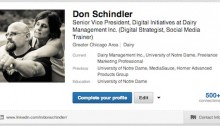Tag: Linkedin
-
Are You Ready To Join The Social Media Revolution at the 2014 Joint Annual Meeting?
Facebook, Instagram, Twitter, and Pinterest are places where your customers are taking about their experiences with dairy. DMI is excited to bring you customized social media training just for the dairy industry. On Oct. 29, Jamie and I will be teaching social media and digital communications from 2:15 – 5 pm at Partners in Progress,…
-

Why should you be using LinkedIn as an executive?
Most people would probably question me about why I’m so passionate about technologies that many people would consider old-fashioned in the digital age. Like LinkedIn and blogging. But let me explain why I believe that Linkedin still has a lot going for it. Even more than many other networks (looking at you Facebook and Twitter).…
-
Five Simple Steps on How to Set Up a Linkedin Profile
Originally,I put together six reasons why I believe you should in using Linkedin. This is a business social network Farmers are missing from Linkedin Your network can benefit your family, friends and the industry Your rolodex will automatically be updated It becomes a strong part of your digital profile Meet new people via groups and…
-
Six Reasons on Why You Should be Using Linkedin for Yourself and Your Farm
With over 259 million members and growing at rate of two new members per second, Linkedin is the premier business social network and there are many reasons that I believe it is in your best interest to set up a profile and get a company page for your farm and/or business. If you want to…
-
How social media savvy are your employees? How to do a social media audit of your team.
“How experienced is my staff at using social media?” I get this a lot from senior marketers and communication folks. They want to know how experienced the staff is at using social media tools. It’s tough for senior staff to gauge this because they don’t use social media as much as the younger staff. So…